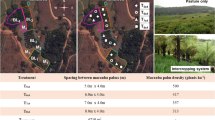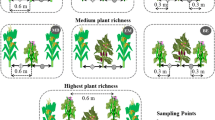Abstract
In Minas Gerais, Brazil, Eucalyptus plantation agroforestry techniques for small farms appear to be an adequate alternative to small-scale plantations, and by integrating timber and food production, they can meet local demands for aliment and wood. Intercropping of Eucalyptus camaldulensis with rice and beans was studied to compare yields of intercropping and monocultures over 2 years. In the first year, no differences were found in the productivity between the intercropped and monoculture systems of E. camaldulensis, rice and beans in both seasons. In the second year, E. camaldulensis in monoculture showed the lowest productivity. If compared with E. camaldulensis intercropped with agricultural crops, during the rainy season, beans intercropped with E. camaldulensis showed similar productivity when compared to monoculture. In the dry season, the productivity of beans in monoculture was higher than intercropping. In the second year, rice productivity was very low for both systems due to the lack of precipitation during the fructification phase. The equivalence area index (EAI) confirmed the advantages of the intercropping system over the monoculture system for E. camaldulensis and beans and rice, at least in the first 2 years.
Similar content being viewed by others
References
J.C.C. Almeida (1990) Comportamento inicial de Eucalyptusus citriodora Hookerem areas submetidas ao pastejo com bovinos e ovinos no Vale do Rio DoceMinas Gerais Universidade Federal de Viçosa Imprensa Universitaria Minas Gerais, Brazil
J.B. Assis E. Silva J.C.A. Araujo (1986) ArticleTitleDesempenho do reflorestamento em pequenos e médios imóveis na Zona da Mata Silvicultura 41 50–55
Biblioteca Municipal de Divino’ polis 1992. Dados geogra’ficos de Divino’ polis. Minas Gerais, Brazil, 4 p.
J. Bedê P. Barezzani (1991) Projeto empresario agroflorestal – um modelo sustentado Pains Florestal Minas Gerais, Brazil
J.S. Boyer (1982) ArticleTitlePlant productivity and environment Science 218 443–448
E. Campinhos SuffixJr. (1999) ArticleTitleSustainable plantations of high-yield Eucalyptus trees for production of fiber: the Aracruz case New Forests 17 129–143 Occurrence Handle10.1023/A:1006562225915
E. Ceccon (1999) ArticleTitleLevantamento do nível tecnológico utilizado por parceiros no plantio de eucalipto de uma empresa reflorestadora na região de Divinópolis Minas Gerais, Brasil Revista Árvore 23 IssueID(3) 301–310
E. Ceccon M.A.P. Ramalho A.F.B. Abreu M.J.B. Andrade (1999) ArticleTitleConsórcio entre Eucalyptus camaldulensis Dehn., aos três anos de idadee diferentes cultivares de feijão (Phaseolus vulgaris L.) Revista Árvore 23 IssueID(1) 9–14
Couto L. and Betters D.R. 1995. Short-rotation eucalypt plantations in Brazil: social and environmental issues. Oak Ridge National Laboratory. ORNL=TM-12846. Springfield, USA.
Couto L., Passos C.A.M., Ceccon E. and Firme D.J. 1996. Avaliac¸a˜o da produtividade do consorcio do Eucalyptus urophylla com feija˜o na regia˜o de Divinopolis. In: 48 Simposio Internacional sobre Ecossistemas Florestais, Biosfera, Belo Horizonte, pp. 360–360.
R.F. Euclides (1983) Sistema para análisis estatisticas e genéticas (SAEG) Central de procesamento de dados Universidade Federal de Viçosa Minas Gerais
P.S. Ferreira Neto (1993) Comportamento inicial de Eucalyptus grandis W Hill ex maiden em plantio consorciado com leguminosas na Região do Médio Rio DoceMinas Gerais Universidade Federal de Viçosa Imprensa Universitaria Minas Gerais, Brazil
P. van der Hout (1983) Effects of wider initial spacing of teak on income and income distribution in the Taungya-System on Java. Ph.D. Dissertation, Department of Forestry Management Agricultural University Wageningen The Netherlands
IBGE 2001. Instituto Brasileiro de Geografia e Estatisca, Governo do Brasil.
J.M. Leiva (1994) Evaluation of three forest tree species in pure plantation and Taungya system in the upper Achiguate WatershedGuatemala University of San Carlos of GuatemalaFaculty of Agronomy, Institute of Agronomical Research International Foundation for Science Guatemala
N. Lisanework M. Michelsen (1993) ArticleTitleAllelopathy in agroforestry systems: the effects of leaf extracts of Cupressus lusitanicathree Eucalyptus spp. on four Ethiopian crops Agrofor. Syst. 21 63–74 Occurrence Handle10.1007/BF00704926
J.L. Magalhães (1993) Futuro do carvão vegetal no contexto nacional e internacional Anais. Simpósio Brasileiro de Pesquisa Florestal Society for Forestry Research Belo HorizonteBrazil 59–240
T.M. Nissen T.J. Midmore M.L. Cabrera (1999) ArticleTitleAboveground and belowground competition between intercropped cabbage and young Eucalyptus torelliana Agrofor. Syst. 46 83–93 Occurrence Handle10.1023/A:1006261627857
L.G. Paleg D. Aspinall (Eds) (1981) Physiology and Biochemistry of Drought Resistance in Plants Academic Press Australia
C.A.M. Passos (1996) Sistemas agroflorestais com eucalipto para uso em programas de fomento florestal, na região de Divinópolis, Minas Gerais. D.Sc. Universidade Federal de Viçosa ViçosaBrazil
A. Schlönvoigt J. Beer (2001) ArticleTitleInitial growth of pioneer timber tree species in a Taungya system in the humid lowlands of Costa Rica Agrofor. Syst. 51 IssueID(2) 97–108 Occurrence Handle10.1023/A:1010674402907
H.G. Schreiner E.A. Balloni (1986) ArticleTitleConsórcio de culturas de feijão (Phaseolus vulgaris) e eucalipto (Eucalyptus grandis W. Hill ex Maiden) no sudeste do Brazil EMBRAPA Bol. de Pesq. Florestal 12 83–104
J.L. Stape E.L. Martini (1992) Plantio consorciado de eucalyptus e arroz na região de Itararé – SP Anais. Vol. I. 2o Encontro Brasileiro de Economia e Planejamento Florestal – Sistemas Agroflorestais no Brasil: Aspectos Técnicos e econômicos EMBRAPA Brazil 155–169
K. Sungsumarn (1993) Why is eucalypt not adopted for agroforestry? Proceedings of the Regional Expert Consultation on Eucalyptus FAO Regional Office for Asia and the Pacific Bangkok 194
J.E. da Veiga (1996) ArticleTitleAgricultura Familiar e Sustentabilidade Cadernos de Ciência e Tecnologia. EMBRAPA 13 IssueID(3) 383–404
R.W. Willey R.J.O. Osiru (1972) ArticleTitleStudies on mixture maize and beans with particular reference to plant population J. Agric. Sci. New York 79 516–529
R.A. Wilson R. Astorga C. Gomes F. Gonzales-Rio (19951995) Papermaking with DNA. ȁ8Intelligent Fibre.ȁ9 B.M. Potts N.M.G. Borralho J.B. Reid R.N. Cromer W.N. Tibbitts C.A. Raymond (Eds) Eucalypt Plantations: Improving Fibre Yield and Quality. Proceedings of the Cooperative Centre for Temperate Hardwood Forestry–International Union of Forestry Research Organizations Conference The Cooperative Centre for Temperate Hardwood Forestry Hobart TasmaniaAustralia
Author information
Authors and Affiliations
Corresponding author
Rights and permissions
About this article
Cite this article
Ceccon, E. Eucalyptus agroforestry system for small farms: 2-year experiment with rice and beans in Minas Gerais, Brazil. New Forest 29, 261–272 (2005). https://doi.org/10.1007/s11056-005-5655-1
Received:
Accepted:
Issue Date:
DOI: https://doi.org/10.1007/s11056-005-5655-1




